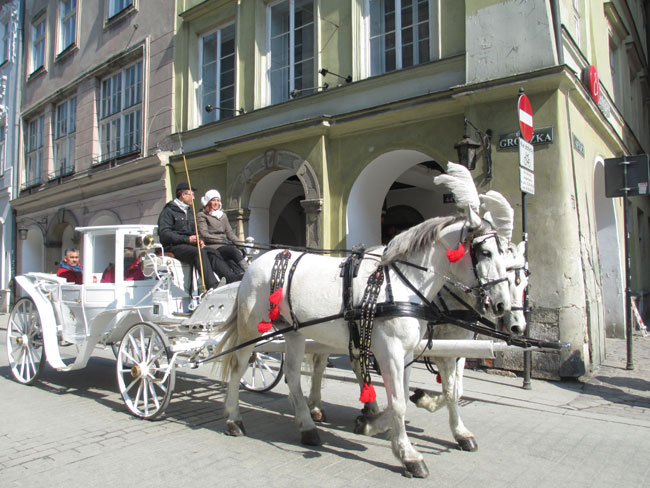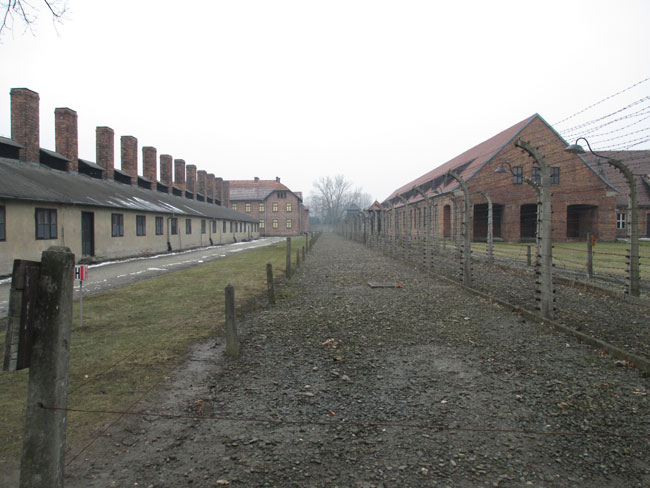Kraków has traditionally been one of the leading centres of Polish academic, cultural, and artistic life and is one of Poland's most important economic hubs. It was the capital of Poland from 1038 to 1569. The city, situated on the Vistula River in the Lesser Poland region, is nowadays the second largest and one of the oldest cities in Poland.
The name of Kraków is traditionally derived from Krakus (Krak, Grakch), the legendary founder of Kraków and a ruler of the tribe of Lechitians (Poles).
 |
| Wawel Hill – a Jurassic limestone rock, a dominant feature in the landscape of Kracow was formed about 150 million years ago. Early medieval legends tell stories about a dreadful dragon that lived in a cave on Wawel Hill, about his slayer Krakus, and about the latter’s daughter Wanda, who drowned herself in the Vistula rather than marry a German knight. |
 |
| During the reign of Casimir the Restorer (1034-1058) Wawel became a significant political and administrative centre for the Polish State. Casimir’s son, Boleslas the Bold began the construction of a second Romanesque cathedral, which was finished by Boleslas the Wrymouth. |
 |
The Italian Renaissance arrived at Wawel in the early 16th century. King Alexander (1501-1506) and his brother Sigismund I the Old (1506-1548) commissioned the construction of a new palace in place of the Gothic residence, with an impressive large courtyard with arcaded galleries which was completed about 1540.

 |
| One of Kraków’s most beautiful streets is ul. Kanonicza. The late Pope John Paul II’s former residence is at numbers 19-21, which now house the Archdiocesan Museum. |
 |
| In 1978, Karol Wojtyła, archbishop of Kraków, was elevated to the papacy as Pope John Paul II – the first Slavic pope ever, and the first non-Italian pope in 455 years. |



 |
| The Renaissance Sukiennice (Cloth Hall, Drapers' Hall) is one of the city's most recognizable icons. It is the central feature of the Main Market Square in the Kraków Old Town, which has been listed as the UNESCO World Heritage Site since 1978. It was once a major centre of international trade. Traveling merchants met there to discuss business and to barter. During its golden age in the 15th century, Sukiennice was the source of a variety of exotic imports from the East – spices, silk, leather and wax – while Kraków itself exported textiles, lead, and salt from the Wieliczka Salt Mine. |
 |
| Palm Sunday marks the official beginning of Poland’s Easter festivities – the country’s most sacred holiday. Leading up to the season you'll see decorative handmade palms for sale all over Kraków's market square. These traditional decorations made from a variety of dried flowers and plants are crafted in villages all over Poland. Palms are taken to church on Sunday to be blessed before decorating homes for the duration of the season. |

St. Mary's Basilica - Church of Our Lady Assumed into Heaven - is a Brick Gothic church re-built in the 14th century. Every hour on the half hour, a trumpet signal - called the Hejnał mariacki - is played from the top of the taller of St. Mary's two towers. The plaintive tune breaks off in mid-stream, to commemorate the famous 13th century trumpeter, who was shot in the throat while sounding the alarm before the Mongol attack on the city. The noon-time Hejnał is heard across Poland and abroad broadcast live by the Polish national Radio 1 Station.
|
 |
 |
| The Jagiellonian University was established in 1364 by Casimir III the Great in Kazimierz. It is the oldest university in Poland, the second oldest university in Central Europe and one of the oldest universities in the world. |
Marking the edge of the Old Town is Floriańska Gate. Completed in 1307 the gateway is one of the few surviving parts of the ancient defences that once circled the Old Town. Thirty-three metres tall, and topped with a Baroque roof that was added in 1657, the gate marks the main entrance into the old city, and was the original starting point for what was dubbed the Royal Road. It was through this gate that visiting kings, queens and nobility would enter the city on their way to Wawel.
 |
| Galeria Krakowska: 270 specialty shops, cafés, and restaurants on three floors in two roof-covered shopping malls and three plazas. It is part of an urban renewal project named ‘Nowe Miasto’ (New City) where instead of building shopping centres in greenfield land, the German project developer, ECE developed Galeria Krakowska in the busy inner city. |
 |
| After years of preparation, the Oskar Schindler Enamelled Goods Factory re-opened to the public as a world-class museum in June 2010. The story of Oskar Schindler and his employees is one which has been well-known since the book and film by Thomas Keneally and Steven Spielberg (whose film Schindler’s List was shot almost entirely in Kraków), and while that story is now covered in detail on the original site, the museum casts the city of Kraków in the main role of its permanent exhibition titled, ‘Kraków During Nazi Occupation 1939-1945.’ |
 |
| Consistently excellent meals have seen Miód Malina establish themselves as one of the top restaurants in town, so book ahead if you fancy taking in the Grodzka views afforded by the raised window-side seating. The prices remain pegged generously low making a visit here not just recommended (as the Michelin Guide 2012 did) but essential. |














































































